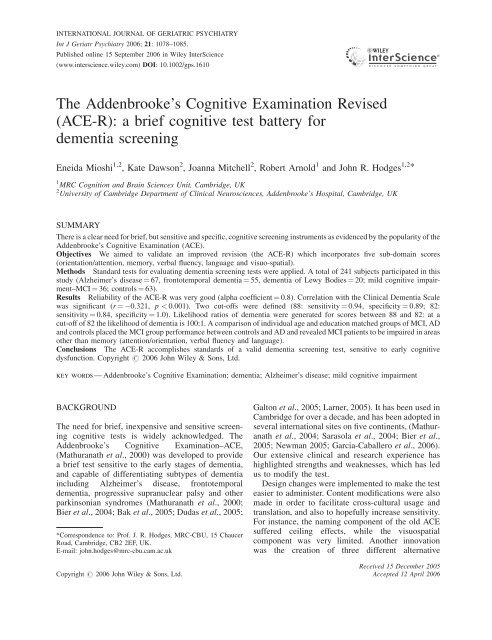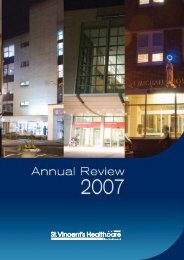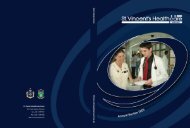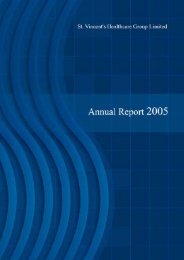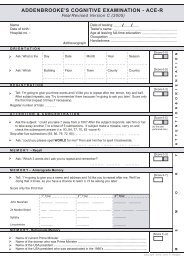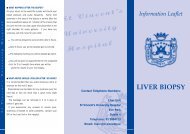The Addenbrooke's Cognitive Examination Revised (ACE-R): a brief ...
The Addenbrooke's Cognitive Examination Revised (ACE-R): a brief ...
The Addenbrooke's Cognitive Examination Revised (ACE-R): a brief ...
You also want an ePaper? Increase the reach of your titles
YUMPU automatically turns print PDFs into web optimized ePapers that Google loves.
INTERNATIONAL JOURNAL OF GERIATRIC PSYCHIATRY<br />
Int J Geriatr Psychiatry 2006; 21: 1078–1085.<br />
Published online 15 September 2006 in Wiley InterScience<br />
(www.interscience.wiley.com) DOI: 10.1002/gps.1610<br />
<strong>The</strong> Addenbrooke’s <strong>Cognitive</strong> <strong>Examination</strong> <strong>Revised</strong><br />
(<strong>ACE</strong>-R): a <strong>brief</strong> cognitive test battery for<br />
dementia screening<br />
Eneida Mioshi 1,2 , Kate Dawson 2 , Joanna Mitchell 2 , Robert Arnold 1 and John R. Hodges 1,2 *<br />
1 MRC Cognition and Brain Sciences Unit, Cambridge, UK<br />
2 University of Cambridge Department of Clinical Neurosciences, Addenbrooke’s Hospital, Cambridge, UK<br />
SUMMARY<br />
<strong>The</strong>re is a clear need for <strong>brief</strong>, but sensitive and specific, cognitive screening instruments as evidenced by the popularity of the<br />
Addenbrooke’s <strong>Cognitive</strong> <strong>Examination</strong> (<strong>ACE</strong>).<br />
Objectives We aimed to validate an improved revision (the <strong>ACE</strong>-R) which incorporates five sub-domain scores<br />
(orientation/attention, memory, verbal fluency, language and visuo-spatial).<br />
Methods Standard tests for evaluating dementia screening tests were applied. A total of 241 subjects participated in this<br />
study (Alzheimer’s disease ¼ 67, frontotemporal dementia ¼ 55, dementia of Lewy Bodies ¼ 20; mild cognitive impairment–MCI<br />
¼ 36; controls ¼ 63).<br />
Results Reliability of the <strong>ACE</strong>-R was very good (alpha coefficient ¼ 0.8). Correlation with the Clinical Dementia Scale<br />
was significant (r ¼ 0.321, p < 0.001). Two cut-offs were defined (88: sensitivity ¼ 0.94, specificity ¼ 0.89; 82:<br />
sensitivity ¼ 0.84, specificity ¼ 1.0). Likelihood ratios of dementia were generated for scores between 88 and 82: at a<br />
cut-off of 82 the likelihood of dementia is 100:1. A comparison of individual age and education matched groups of MCI, AD<br />
and controls placed the MCI group performance between controls and AD and revealed MCI patients to be impaired in areas<br />
other than memory (attention/orientation, verbal fluency and language).<br />
Conclusions <strong>The</strong> <strong>ACE</strong>-R accomplishes standards of a valid dementia screening test, sensitive to early cognitive<br />
dysfunction. Copyright # 2006 John Wiley & Sons, Ltd.<br />
key words — Addenbrooke’s <strong>Cognitive</strong> <strong>Examination</strong>; dementia; Alzheimer’s disease; mild cognitive impairment<br />
BACKGROUND<br />
<strong>The</strong> need for <strong>brief</strong>, inexpensive and sensitive screening<br />
cognitive tests is widely acknowledged. <strong>The</strong><br />
Addenbrooke’s <strong>Cognitive</strong> <strong>Examination</strong>–<strong>ACE</strong>,<br />
(Mathuranath et al., 2000) was developed to provide<br />
a <strong>brief</strong> test sensitive to the early stages of dementia,<br />
and capable of differentiating subtypes of dementia<br />
including Alzheimer’s disease, frontotemporal<br />
dementia, progressive supranuclear palsy and other<br />
parkinsonian syndromes (Mathuranath et al., 2000;<br />
Bier et al., 2004; Bak et al., 2005; Dudas et al., 2005;<br />
*Correspondence to: Prof. J. R. Hodges, MRC-CBU, 15 Chaucer<br />
Road, Cambridge, CB2 2EF, UK.<br />
E-mail: john.hodges@mrc-cbu.cam.ac.uk<br />
Copyright # 2006 John Wiley & Sons, Ltd.<br />
Galton et al., 2005; Larner, 2005). It has been used in<br />
Cambridge for over a decade, and has been adopted in<br />
several international sites on five continents, (Mathuranath<br />
et al., 2004; Sarasola et al., 2004; Bier et al.,<br />
2005; Newman 2005; Garcia-Caballero et al., 2006).<br />
Our extensive clinical and research experience has<br />
highlighted strengths and weaknesses, which has led<br />
us to modify the test.<br />
Design changes were implemented to make the test<br />
easier to administer. Content modifications were also<br />
made in order to facilitate cross-cultural usage and<br />
translation, and also to hopefully increase sensitivity.<br />
For instance, the naming component of the old <strong>ACE</strong><br />
suffered ceiling effects, while the visuospatial<br />
component was very limited. Another innovation<br />
was the creation of three different alternative<br />
Received 15 December 2005<br />
Accepted 12 April 2006
ace-r: a <strong>brief</strong> cognitive test battery for dementia screening 1079<br />
versions–A, B and C, with different stimuli for the<br />
name and address recall, in order to prevent recalling<br />
from previous clinic visits. Finally, the individual<br />
26 components were combined to produce five<br />
sub-scores, each one representing a specific cognitive<br />
domain and contributing fairly equally to the total<br />
score.<br />
<strong>The</strong> first aim in this study was to demonstrate that<br />
these changes could improve sensitivity and specificity<br />
for detecting dementia based upon likelihood<br />
ratios that could fill the gap between the two currently<br />
used cut-off scores. As well as providing more detailed<br />
normative data for the <strong>ACE</strong>-R total score, we aimed to<br />
provide normative sub-scale scores. Given the<br />
importance of early detection in dementia we aimed<br />
to define the profile of performance on the <strong>ACE</strong>-R in<br />
patients with mild cognitive impairment (MCI).<br />
Finally, we aimed to analyse its properties in order<br />
to validate the <strong>ACE</strong>-R for clinical use.<br />
METHODS<br />
<strong>The</strong> instrument<br />
<strong>The</strong> <strong>ACE</strong>-R takes between 12 and 20 min (average 16)<br />
to administer and score in a clinical setting. It contains<br />
5 sub-scores, each one representing one cognitive<br />
domain: attention/orientation (18 points), memory<br />
(26 points), fluency (14 points), language (26 points)<br />
and visuospatial (16 points). <strong>ACE</strong>-R maximum score<br />
is 100, composed by the addition of the all domains.<br />
Modifications. <strong>The</strong> attention/orientation components<br />
were not modified. In the memory domain several<br />
changes were made: the name and address test scoring<br />
was modified so that only the final trial contributed to<br />
the sub-score, and a recognition component was<br />
added. Three versions of the name and address recall<br />
and recognition test were designed. Retrograde<br />
memory questions were simplified as controls had<br />
difficulty answering previous ones, which were also<br />
not easily translated. <strong>The</strong>se changes reduced the<br />
memory domain weight in the final score, which<br />
allowed other domains to have a more balanced<br />
contribution to the final score. <strong>The</strong> fluency tests had<br />
their scaling scoring revised. In the language domain,<br />
comprehension of commands was removed, new<br />
semantic comprehension questions were added, the<br />
pictures for the naming test were changed to reduce<br />
ceiling effects and reading of regular words was<br />
excluded. Adding new tasks of perceptual abilities,<br />
counting of dot arrays and identification of fragmented<br />
letters augmented the visuospatial domain. <strong>The</strong><br />
scoring of the clock face drawing was expanded<br />
(0–5) to reflect a better range of abilities.<br />
<strong>The</strong>se changes underwent numerous cycles of<br />
interactive modification after piloting in various<br />
patients before the final version of the <strong>ACE</strong>-R was<br />
given to the patients and controls reported here.<br />
Participants<br />
A total of 241 subjects participated, consisting of three<br />
groups: a dementia group (Alzheimer’s disease ¼ 67,<br />
frontotemporal dementia ¼ 55, dementia of Lewy<br />
Bodies ¼ 20), a mild cognitive impairment–MCI<br />
group (n ¼ 36) and a control group (n ¼ 63).<br />
Dementia group<br />
This group comprised of consecutive patients assessed<br />
in one of our three cognitive clinics at Addenbrooke’s<br />
Hospital (Memory Clinic, Early Onset Dementia<br />
Clinic and Drug monitoring Clinic) between May<br />
2004 and March 2005. Subjects were included in the<br />
study if: (1) they could perform the assessment; (2)<br />
had a carer; (3) the Clinical Dementia Rating (Morris,<br />
1997) had been completed within 90 days. <strong>The</strong>y were<br />
excluded if presenting: (1) a significant psychiatric<br />
disorder (depression, schizophrenia); (2) evidence of a<br />
mixed concomitant dementia processes (e.g. AD and<br />
vascular dementia); and (3) causes of cognitive<br />
impairment other than neurodegenerative disease<br />
(e.g. epilepsy, head injury, alcoholism). Criteria used<br />
for selecting patients for the study were similar to<br />
those used for the validation of the first version<br />
(Mathuranath et al., 2000). For classifying subgroups<br />
of dementia we used the following criteria: National<br />
Institute of Neurological and Communicative Disorders<br />
and Stroke/Alzheimer’s Disease and Related<br />
Disorders Association–NINCDS-ADRDA (McKhann<br />
et al., 1984) and the FTD consensus criteria (Neary<br />
et al., 1998). FTD group here comprises the three<br />
variants–Frontal variant FTD, Semantic Dementia and<br />
Progressive non-fluent Aphasia. Dementia with Lewy<br />
bodies (DLB) was diagnosed in accordance with the<br />
McKeith et al. criteria (2000).<br />
MCI group<br />
Patients met widely accepted criteria for amnestic<br />
MCI, notably: (1) memory complaint, corroborated by<br />
an informant; (2) abnormal memory function,<br />
documented by a delayed recall of one paragraph<br />
from the Logical Memory II subtest of the Wechsler<br />
Memory Scale <strong>Revised</strong>; (3) normal general cognitive<br />
Copyright # 2006 John Wiley & Sons, Ltd. Int J Geriatr Psychiatry 2006; 21: 1078–1085.<br />
DOI: 10.1002/gps
1080 e. mioshi ET AL.<br />
function, as determined by a clinician’s judgement<br />
based on a structured interview with the patient and an<br />
informant and a Mini-Mental State <strong>Examination</strong><br />
(MMSE) score greater than or equal to 24; (4) no<br />
or minimal impairment in activities of daily living<br />
(ADLs), as determined by a clinical interview with the<br />
patient and an informant; and (5) not sufficiently<br />
impaired, cognitively and functionally, to meet<br />
National Institute of Neurological and Communicative<br />
Disorders and Stroke/Alzheimer’s Disease and<br />
Related Disorders Association criteria for AD (Grundman<br />
et al., 2004).<br />
Control group<br />
Controls (n ¼ 63) were recruited from the volunteer<br />
panel at the Medical Research Council, Brain Sciences<br />
Unit (n ¼ 43) or were spouses of patients attending the<br />
clinics (n ¼ 18) (see Table 1).<br />
Statistical analyses<br />
Statistical analyses were either performed using the<br />
Statistical Package for the Social Sciences 11 for<br />
Windows (SPSS Inc., Chicago, IL USA) or Excel for<br />
Windows XP (Microsoft, USA).<br />
Demographics and <strong>ACE</strong>-R sub-scores were compared<br />
across different groups’ means using independent<br />
t-tests, applying Levene’s test for equality of<br />
variance and Bonferroni corrections.<br />
Reliability was calculated using the Cronbach alpha<br />
coefficient (McDowell and Newell, 1996). Concurrent<br />
and convergent validity was calculated using a twotailed<br />
Spearman correlation between <strong>ACE</strong>-R final<br />
scores and CDR scores (McDowell and Newell, 1996;<br />
Streiner, 2003b). Sensitivity, specificity, positive<br />
predictive values and negative predictive values were<br />
calculated using discriminant analyses. Likelihood<br />
ratios of probability of dementia were based on the<br />
above discriminant analyses’ results (Sackett et al.,<br />
1991). <strong>ACE</strong>-R comparisons with <strong>ACE</strong> were performed<br />
using simple t-tests.<br />
Descriptive analysis of MCI, AD and control<br />
performance was generated by analysis of variance<br />
and t-tests.<br />
RESULTS<br />
Reliability and validity<br />
<strong>The</strong> alpha coefficient of the <strong>ACE</strong>-R was 0.80, which is<br />
considered very good (McDowell and Newell, 1996;<br />
Streiner, 2003a). In order to assess concurrent and<br />
convergent validity, the <strong>ACE</strong>-R was compared to the<br />
CDR. Spearman rho correlation coefficient between<br />
<strong>ACE</strong>-R and CDR was significant ( 0.321, two<br />
tailed, p < 0.000). <strong>The</strong> negative value reflects the fact<br />
that as CDR scores increase, <strong>ACE</strong>-R total scores<br />
decrease.<br />
Table 1. Comparison of demographic data, MMSE, <strong>ACE</strong>-R total and sub-scores in control, MCI and dementia groups (n ¼ 241, standard<br />
deviation in parenthesis)<br />
Control<br />
n ¼ 63<br />
MCI<br />
n ¼ 36<br />
Dementia<br />
n ¼ 142<br />
Dementia vs<br />
Control<br />
p values<br />
Dementia vs<br />
MCI<br />
p values<br />
MCI vs<br />
Control<br />
p values<br />
Gender, male 28 17 99<br />
Age 64.4 (5.7) 68.8 (9) 65.7 (8) n.s. n.s. n.s.<br />
Education, years 12.7 (2.1) 12.8 (3.4) 11.9 (2.7) n.s. n.s. n.s.<br />
MMSE 28.8 (1.3) 27.7 (1.5) 22.8 (4.3) ** ** **<br />
<strong>ACE</strong>-R total score<br />
93.7 (4.3) 84.2 (7.3) 65.4 (15.9) ** ** **<br />
100 points maximum<br />
Attention & Orientation 17.7 (0.5) 17.2 (1) 14.4 (3.2) ** ** n.s.<br />
18 points maximum<br />
Memory<br />
23.4 (2.7) 17.8 (4.7) 12.4 (5.8) ** ** **<br />
26 points maximum<br />
Fluency<br />
11.9 (1.7) 10.1 (2.4) 6 (3.5) ** ** **<br />
14 points maximum<br />
Language<br />
25.1 (1.5) 23.9 (1.6) 20 (5.6) ** ** *<br />
26 points maximum<br />
Visuospatial<br />
16 points maximum<br />
15.7 (0.7) 14.9 (2) 12.6 (3.5) ** ** n.s.<br />
n.s ¼ non significant.<br />
*p < 0.005. Levene’s test for equality of variance; Bonferroni corrected.<br />
**p < 0.001.<br />
Copyright # 2006 John Wiley & Sons, Ltd. Int J Geriatr Psychiatry 2006; 21: 1078–1085.<br />
DOI: 10.1002/gps
ace-r: a <strong>brief</strong> cognitive test battery for dementia screening 1081<br />
Table 2. Lower limit of normal (cut-off scores) for total <strong>ACE</strong>-R and sub-scores according to age (50–59, 60–69, 70–75), showing control<br />
mean minus two standard deviations<br />
Age range<br />
Education<br />
(years)<br />
Total <strong>ACE</strong>-R<br />
score<br />
Attention/Orientation Memory Fluency Language Visuospatial<br />
50–59 12.7 86 17 18 9 24 15<br />
60–69 12.9 85 17 19 8 21 14<br />
70–75 12.1 84 16 17 9 22 14<br />
Normative data<br />
Control data were used to generate normative scores<br />
for the total <strong>ACE</strong>-R and domain sub-scores based<br />
upon the mean minus two standard deviations for<br />
three age bands (50–59; 60–69; 70–75). As shown in<br />
Table 2, there was relatively little effect of age. A<br />
mixed ANOVA revealed that there was no main effect<br />
of age range (F (5,300) ¼ 1.449, p ¼ 0.243), and the age<br />
range by <strong>ACE</strong>-R sub-scores interaction was not<br />
significant (F (5,300) ¼ 1.659; p ¼ 0.090). <strong>The</strong> lower<br />
limit of normal, as judged by the controls’ total score<br />
minus two standard deviations, decreased by one point<br />
only from the younger to the older age group.<br />
Attention/Orientation score decreased one point for<br />
the older group in comparison to the other two.<br />
Memory score increased one point from the younger<br />
to the next age range group, and then dropped<br />
two points for the oldest group. Fluency score was<br />
the same for the younger and older groups, varying<br />
one point lower for the mid range age group.<br />
Visuospatial score decreased one point for the two<br />
older groups.<br />
Likelihood ratios were calculated for several cut-off<br />
scores based on the sensitivity and specificity<br />
analyses. <strong>The</strong> likelihood ratio contrasts the proportions<br />
of patients with and without dementia and<br />
reflects the odds that a given score is likely to come<br />
from a patient with dementia (Sackett et al., 1991). As<br />
shown in Table 4, with descending cut-offs from 88 to<br />
82, the likelihood ration rate rose from 8.4 to 100,<br />
which means that a score of 82 is 100 times more<br />
likely to come from a patient with dementia than one<br />
without.<br />
<strong>ACE</strong>-R versus <strong>ACE</strong><br />
A direct comparison of controls’ performance in the<br />
old and new <strong>ACE</strong> is shown in Figure 1a. Sub-score<br />
analyses revealed significantly better performance on<br />
the memory and visuospatial domains (t ¼ 3.071,<br />
df ¼ 44, p < 0.05; t ¼ 3.789, df ¼ 43, p < 0.001,<br />
respectively) and significant difference in the total<br />
score on the <strong>ACE</strong>-R (t ¼ 2.115, df ¼ 45, p ¼ 0.04). For<br />
the dementia group (Figure 1b), there were significant<br />
Diagnostic interpretation<br />
Cut-off scores: two total <strong>ACE</strong>-R cut-offs (88 and 82)<br />
were identified based on the calculations of sensitivity,<br />
specificity and positive predictive values (PPV) at<br />
different prevalence rates. As shown in Table 3, the<br />
PPV rose to 1.00 at the lower cut-off regardless of the<br />
estimated prevalence rate. <strong>The</strong> higher cut-off (88) had<br />
a better sensitivity (94%) but lower PPV especially<br />
with low prevalence rates.<br />
Table 4. Likelihood ratios for probability of dementia at various<br />
<strong>ACE</strong>-R cut-off scores<br />
<strong>ACE</strong>-R score<br />
Likelihood ratio of dementia<br />
88 8.43<br />
87 11.5<br />
86 14.2<br />
85 18.9<br />
84 27.6<br />
83 52.5<br />
82 100<br />
Table 3. Sensitivity, Specificity and Positive Predictive Values (PPV) at different prevalence rates of two cut-off total <strong>ACE</strong>-R scores. Values<br />
in parentheses represent the respective Negative Predictive Value<br />
<strong>ACE</strong>-R cut off Dementia PPV at different prevalence rates<br />
Sensitivity Specificity 5% 10% 20% 40%<br />
88 0.94 0.89 0.31 (1.0) 0.48 0.68 0.85 (1.0)<br />
82 0.84 1.00 1.0 (0.96) 1.0 1.0 1.0 (0.90)<br />
Copyright # 2006 John Wiley & Sons, Ltd. Int J Geriatr Psychiatry 2006; 21: 1078–1085.<br />
DOI: 10.1002/gps
1082 e. mioshi ET AL.<br />
Figure 1. a: Comparison of performance on <strong>ACE</strong> and <strong>ACE</strong>-R in controls (n ¼ 63). **p < 0.001, *p < 0.05. b: Comparison of performance<br />
on <strong>ACE</strong> and <strong>ACE</strong>-R in dementia patients (n ¼ 142). **p < 0.001, *p < 0.05<br />
differences in total and in each domain score except<br />
for the visuospatial domain (total score t ¼ 6.528,<br />
df ¼ 136, p < 0.001; memory t ¼ 4.534, df ¼ 134,<br />
p < 0.001; fluency t ¼ 3.932, df ¼ 134, p < 0.001).<br />
Higher scores were found on the total <strong>ACE</strong>-R,<br />
memory and visuospatial, but lower scores for fluency<br />
and language.<br />
<strong>The</strong> VLOM ratio<br />
<strong>The</strong> VLOM ratio sub-score was designed to differentiate<br />
AD from FTD patients. It comprises the ratio of<br />
the scores of verbal fluency plus language to orientation<br />
plus name and address delayed recall memory (V þ L)/<br />
(O þ M). For this analysis we included the dementia<br />
patients (n ¼ 88) who had a CDR < or ¼ 1(AD¼ 49,<br />
FTD ¼ 21, DLB ¼ 12). We applied the same criteria for<br />
calculating the VLOM ratio to distinguish AD from<br />
FTD, which were published on the first <strong>ACE</strong> paper<br />
(Mathuranath et al., 2000), and found that sensitivity<br />
and specificity values were virtually identical. Figure 2<br />
shows that a VLOM ratio of < 2.2 could differentiate<br />
FTD from non-FTD (sensitivity of 58% and specificity<br />
of 95%) and a VLOM ratio of > 3.2 could differentiate<br />
AD from non-AD (sensitivity of 74% and specificity of<br />
85%).<br />
Copyright # 2006 John Wiley & Sons, Ltd. Int J Geriatr Psychiatry 2006; 21: 1078–1085.<br />
DOI: 10.1002/gps
ace-r: a <strong>brief</strong> cognitive test battery for dementia screening 1083<br />
Figure 2. Bar plot of the VLOM ratio ([verbal fluency þ language]/[orientation þ memory]) against clinical diagnosis (black ¼ FTD,<br />
white ¼ AD, striped ¼ DLB)<br />
AD, MCI and controls: performance on the <strong>ACE</strong>-R<br />
We took subgroups of AD (n ¼ 23) and MCI (n ¼ 23)<br />
patients individually matched to a control group<br />
(n ¼ 23) for age and education. A mixed ANOVA<br />
using the three diagnostic groups and the five <strong>ACE</strong>-R<br />
domains revealed a main effect of diagnosis<br />
(F (2,66) ¼ 43.168, p < 0.001) as well as an interaction<br />
between diagnosis and domains (Greenhouse-Geisser<br />
corrected, F (2,66) ¼ 34.965, p < 0.001). Subsequent t-<br />
tests demonstrated that the MCI group differed<br />
significantly from controls in terms of <strong>ACE</strong>-R final<br />
score (t ¼ 4.462, df ¼ 44, p < 0.001), attention/orientation<br />
(t ¼ 2.727, df ¼ 44, p < 0.05) memory<br />
(t ¼ 4.364, df ¼ 44, p < 0.001), fluency (t ¼ 2.347,<br />
df ¼ 44, p < 0.05), and language (t ¼ 2.730, df ¼ 44,<br />
p < 0.05). Comparing MCI and AD, t-tests revealed<br />
significant differences between <strong>ACE</strong>-R total score<br />
(t ¼ 5.313, df ¼ 44, p < 0.001), attention/orientation<br />
(t ¼ 5.813, df ¼ 44, p < 0.001), memory (t ¼ 5.046,<br />
df ¼ 44, p < 0.001), fluency (t ¼ 2.650, df ¼ 44,<br />
p < 0.05), language (t ¼ 2.591, df ¼ 44, p < 0.05),<br />
and visuospatial (t ¼ 2.813, df ¼ 44, p < 0.05) (see<br />
Table 5).<br />
DISCUSSION<br />
We hoped that changes in the <strong>ACE</strong>-R would result in<br />
better sensitivity and specificity. <strong>The</strong> most striking<br />
finding was the positive predictive value, which was<br />
100% at the lower cut-off of 82 for a range of<br />
prevalence rates. This suggests that the <strong>ACE</strong>-R could<br />
be used to diagnose dementia in settings with very<br />
different expected rates of dementia. This finding is<br />
explicable in the light of the changes in that insensitive<br />
Table 5. Comparison of performance on the <strong>ACE</strong>-R (total and sub-scores) in controls, MCI and AD (n ¼ 23 per group). <strong>ACE</strong>-R sub-scores<br />
shown as percentage since totals vary<br />
Controls (n ¼ 23) MCI (n ¼ 23) AD (n ¼ 23) Controls vs MCI<br />
p-values<br />
MCI vs AD<br />
p-values<br />
<strong>ACE</strong>-R total score 92.6 84.2 66.4 ** **<br />
Attention/Orientation(%) 98.6 95.4 75.4 * **<br />
Memory (%) 88 68.6 42.5 ** **<br />
Fluency (%) 81.7 71.1 53.4 * *<br />
Language (%) 96.7 92.1 84.3 * *<br />
Visuospatial (%) 97 92.9 76.6 n.s. *<br />
Copyright # 2006 John Wiley & Sons, Ltd. Int J Geriatr Psychiatry 2006; 21: 1078–1085.<br />
DOI: 10.1002/gps
1084 e. mioshi ET AL.<br />
components (e.g. early repetition trials of the name<br />
and address, reading of regular words and sentence<br />
comprehension) were excluded from the revised<br />
version. Modifications on the naming test were made<br />
to present pictures with lower familiarity than the first<br />
version (Snodgrass and Vanderwart, 1980). <strong>The</strong><br />
expansion of the visuospatial domain might have also<br />
contributed to better sensitivity and specificity.<br />
<strong>The</strong> table of likelihood ratio offers an extra tool for a<br />
clinician when assessing patients with possible<br />
dementia. Table 4 shows that the likelihood of a<br />
given score coming from a ‘case’ rises from 8 to 100<br />
with cut-offs from 88 to 82.<br />
<strong>The</strong> VLOM ratio analyses of the <strong>ACE</strong>-R replicated<br />
the original results very closely (Mathuranath et al.,<br />
2000), which is not surprising since the elements that<br />
contribute to the ratio were changed little in the<br />
revised version. Although some studies have reported<br />
very similar findings (Sarasola et al., 2004; Garcia-<br />
Caballero et al., 2006), others have not supported the<br />
use of the VLOM ratio (Bier et al., 2004; Larner,<br />
2005). This variance is likely to reflect the use of<br />
different criteria across the studies (number of<br />
patients; level of impairment according to the CDR-<br />
R; <strong>ACE</strong>-R cut-off, and FTD criteria). We suggest that<br />
the VLOM ratio does have clinical utility although it<br />
should be noted that the specificity is much better than<br />
the sensitivity.<br />
An important additional facet of the new study is the<br />
availability of cut-off scores for the five sub-domains<br />
of the <strong>ACE</strong>-R. This allows direct comparison of a<br />
subject’s score in a certain domain against normal<br />
controls performance, thus providing more parameters<br />
for a clinical judgement.<br />
Comparison between MCI and controls revealed<br />
interesting findings. Memory impairment was a key<br />
feature, as expected. This finding seems to agree with<br />
evidence that MCI patients have memory testing<br />
performance that place this group in between normal<br />
ageing people and AD patients. (Petersen et al., 1999;<br />
Bozoki et al., 2001; De Jager et al., 2003; Grundman<br />
et al., 2004). In addition, significant impairment<br />
was also found on attention/orientation, fluency and<br />
language tests. <strong>The</strong>se latter findings suggest that the<br />
<strong>ACE</strong>-R is sensitive to mild cases of dementia, such as<br />
MCI patients, and moreover shows a multi-domain<br />
impairment of MCI patients as a group. Follow up of<br />
the MCI group is needed to explore the usefulness of<br />
the <strong>ACE</strong>-R in predicting convertors to dementia, but<br />
experience with the old <strong>ACE</strong> suggests that a cut-off of<br />
80 distinguishes very well between convertors and nonconvertors<br />
(Galton et al., 2005) and that it compares<br />
favourably with standard neuropsychological tests.<br />
KEY POINTS<br />
<strong>The</strong> <strong>ACE</strong>-R is a <strong>brief</strong>, sensitive and specific test<br />
battery to detect early cognitive dysfunction.<br />
<strong>The</strong> VLOM ratio of the <strong>ACE</strong>-R can be used to<br />
differentiate between AD and FTD.<br />
Copies of the <strong>ACE</strong>-R may be requested without<br />
charge from the corresponding author.<br />
<strong>The</strong> <strong>ACE</strong>-R seems to accomplish satisfactory<br />
standards in terms of reliability and validity based<br />
upon standard criteria for evaluating a dementia<br />
screening test (Gifford and Cummings, 1999). We<br />
also assessed common sources of bias that affect<br />
sensitivity and specificity (Gifford and Cummings,<br />
1999). Spectrum bias was avoided by including in<br />
the study patients with different dementia syndromes<br />
and with a broad range of impairment (MMSE<br />
scores ranging from 9 to 30). Blinding of <strong>ACE</strong>-R<br />
administrators from the patients’ CDR scores<br />
prevented review bias.<br />
<strong>The</strong>re are, however, clear limitations. Our patient<br />
group was relatively young, which reflects the bias of<br />
the Cambridge clinics. It is not clear whether these<br />
findings would apply equally to an older patient group.<br />
In addition, our patient group comprised only cortical<br />
dementia diagnosis, which limits the applicability of<br />
these results in patient groups with subcortical<br />
disorders. <strong>The</strong> original version of the <strong>ACE</strong> has,<br />
however, been shown to be sensitive to cognitive<br />
dysfunction found in the atypical parkinsonian<br />
syndromes, e.g. progressive supranuclear palsy and<br />
corticobasal degeneration (Bak et al., 2005).<br />
This study was developed within a university<br />
hospital setting, therefore reflecting a very specialised<br />
population of patients and professionals involved. A<br />
further step should be the evaluation of the <strong>ACE</strong>-R in<br />
community samples, where the prevalence of dementia<br />
is going to differ considerably from a specialised<br />
service. We omitted test-retest reliability because the<br />
study was done in parallel with clinical appointments<br />
or home visits, which meant that setting up this extra<br />
reliability check would limit significantly the number<br />
of patients involved in the study.<br />
Clinical and research settings have similar demands<br />
but typically have very different resources. Research<br />
settings are often better staffed which allows more<br />
time for assessment, whereas clinical ones need<br />
inexpensive, rapid and practical tests, which can be<br />
given without specialist training. Detailed batteries are<br />
Copyright # 2006 John Wiley & Sons, Ltd. Int J Geriatr Psychiatry 2006; 21: 1078–1085.<br />
DOI: 10.1002/gps
ace-r: a <strong>brief</strong> cognitive test battery for dementia screening 1085<br />
time consuming and require trained testers; on the<br />
other hand, screening tests tend to be too short and<br />
only able to discriminate between demented and nondemented<br />
patients, lacking sensitivity to detect mild<br />
cases and usually not able to make any differentiation<br />
between dementia diagnoses. A test that can be used in<br />
a clinical setting without losing the psychometric<br />
characteristics bridges the clinical and research<br />
realms. It seems that the <strong>ACE</strong>-R can satisfy both<br />
worlds, as reflected by widespread interest in over 150<br />
clinical and research centres in the UK and worldwide<br />
(Portugal, Spain, France, Belgium, Holland,<br />
Italy, Germany, Austria, Switzerland, Hungary, Czech<br />
Republic, Romania, Israel, United States, Canada,<br />
Argentina, Brazil, South Africa, India, Sri Lanka,<br />
Australia and New Zealand).<br />
ACKNOWLEDGEMENTS<br />
We have no conflict of interest to declare. This project<br />
was funded by a Medical Research Council Programme<br />
Grant to JRH.<br />
We would like to thank Samrah Ahmed, Fiona<br />
Clague and Anna Adlam for helping collecting the<br />
data, Brian Cox for assistance in the test design, and<br />
Peter Watson and Michael Hornberger for statistical<br />
advice.<br />
Copies of the <strong>ACE</strong>-R may be obtained without<br />
charge from the corresponding author.<br />
REFERENCES<br />
Bak TH, Rogers TT, Crawford LM, et al. 2005. <strong>Cognitive</strong> bedside<br />
assessment in atypical parkinsonian syndromes. J Neurol Neurosurg<br />
Psychiatry 76(3): 420–422.<br />
Bier JC, Donckels V, Van Eyll E, et al. 2005. <strong>The</strong> French Addenbrooke’s<br />
cognitive examination is effective in detecting dementia<br />
in a French-speaking population. Dement Geriatr Cogn Disord<br />
19(1): 15–17.<br />
Bier JC, Ventura M, Donckels V, et al. 2004. Is the Addenbrooke’s<br />
cognitive examination effective to detect frontotemporal dementia?<br />
J Neurol 251(4): 428–431.<br />
Bozoki A, Giordani B, Heidebrink JL, et al. 2001. Mild cognitive<br />
impairments predict dementia in nondemented elderly patients<br />
with memory loss. Arch Neurol 58(3): 411–416.<br />
De Jager CA, Hogervorst E, Combrinck M, Budge MM. 2003.<br />
Sensitivity and specificity of neuropsychological tests for<br />
mild cognitive impairment, vascular cognitive impairment and<br />
Alzheimer’s disease. Psychol Med 33(6): 1039–1050.<br />
Dudas RB, Berrios GE, Hodges JR. 2005. <strong>The</strong> Addenbrooke’s<br />
cognitive examination (<strong>ACE</strong>) in the differential diagnosis of early<br />
dementias versus affective disorder. Am J Geriatr Psychiatry<br />
13(3): 218–226.<br />
Galton CJ, Erzinclioglu S, Sahakian BJ, et al. 2005. A Comparison<br />
of the Addenbrooke’s <strong>Cognitive</strong> <strong>Examination</strong> (<strong>ACE</strong>), Conventional<br />
Neuropsychological Assessment, and Simple MRI-Based<br />
Medial Temporal Lobe Evaluation in the Early Diagnosis of<br />
Alzheimer’s Disease. Cogn Behav Neurol 18(3): 144–150.<br />
Garcia-Caballero A, Garcia-Lado I, Gonzalez-Hermida J, et al.<br />
2006. Validation of the Spanish version of the Addenbrooke’s<br />
<strong>Cognitive</strong> <strong>Examination</strong> in a rural community in Spain. Int J<br />
Geriatr Psychiatry 21(3): 239–245.<br />
Gifford DR, Cummings JL. 1999. Evaluating dementia screening<br />
tests–methodological standards to rate their performance. Neurology<br />
52: 224–227.<br />
Grundman M, Petersen RC, Ferris SH, et al. 2004. Mild cognitive<br />
impairment can be distinguished from Alzheimer disease and<br />
normal aging for clinical trials. Arch Neurol 61(1): 59–66.<br />
Larner AJ. 2005. An audit of the Addenbrooke’s <strong>Cognitive</strong> <strong>Examination</strong><br />
(<strong>ACE</strong>) in clinical practice. Int J Geriatr Psychiatry 20(6):<br />
593–594.<br />
Mathuranath PS, Hodges JR, Mathew R, et al. 2004. Adaptation of<br />
the <strong>ACE</strong> for a Malayalam speaking population in southern India.<br />
Int J Geriatr Psychiatry 19(12): 1188–1194.<br />
Mathuranath PS, Nestor PJ, Berrios GE, et al. 2000. A <strong>brief</strong><br />
cognitive test battery to differentiate Alzheimer’s disease and<br />
frontotemporal dementia. Neurology 55(11): 1613–1620.<br />
McDowell I, Newell C. 1996. Introduction. In Measuring Health–A<br />
Guide to Rating Scales and Questionnaires, McDowell I, Newell<br />
C (eds). Oxford University Press: Oxford; 3–46.<br />
McKeith IG, Ballard CG, Perry RH, et al. 2000. Prospective<br />
validation of consensus criteria for the diagnosis of dementia<br />
with Lewy bodies. Neurology 54(5): 1050–1058.<br />
McKhann G, Drachman D, Folstein M, et al. 1984. Clinical diagnosis<br />
of Alzheimer’s disease: report of the NINCDS-ADRDA<br />
Work Group under the auspices of Department of Health and<br />
Human Services Task Force on Alzheimer’s Disease. Neurology<br />
34(7): 939–944.<br />
Morris JC. 1997. Clinical dementia rating: a reliable and valid<br />
diagnostic and staging measure for dementia of the Alzheimer<br />
type. Int Psychogeriatr 9 (Suppl. 1): 173–176; discussion 177–<br />
178.<br />
Neary D, Snowden JS, Gustafson L, et al. 1998. Frontotemporal<br />
lobar degeneration: a consensus on clinical diagnostic criteria.<br />
Neurology 51(6): 1546–1554.<br />
Newman J. 2005. Brief Assessment of <strong>Cognitive</strong> Mental Status in<br />
Hebrew: Addenbrooke’s <strong>Cognitive</strong> <strong>Examination</strong>. Israel Medic<br />
Assoc J 7: 451–457.<br />
Petersen RC, Smith GE, Waring SC, et al. 1999. Mild cognitive<br />
impairment: clinical characterization and outcome. Arch Neurol<br />
56(3): 303–308.<br />
Sackett DL, Haynes RB, Guyatt GH, Tugwell P. 1991. Clinical<br />
Epidemiology – A Basic Science for Clinical Medicine. Little,<br />
Brown & Co.: Boston, MA.<br />
Sarasola D, Calcagno ML, Sabe L, et al. 2004. Utilidad del<br />
Addenbrooke’s <strong>Cognitive</strong> <strong>Examination</strong> en Espanol para el Diagnostico<br />
de Demencia y para la diferenciacon entre la Enfermedad<br />
de Alzheimer y la Demencia Frontotemporal. Revista Argentina<br />
de Neuropsicologia 4: 1–11.<br />
Snodgrass JG, Vanderwart M. 1980. A standardized set of 260<br />
pictures: norms for name agreement, image agreement, familiarity,<br />
and visual complexity. J Exp Psychol [Hum Learn] 6(2):<br />
174–215.<br />
Streiner DL, Norman GR. 2003a. Selecting the items. In Health<br />
Measurement Scales – A Practical Guide to <strong>The</strong>ir Development<br />
and Use, Streiner DL, Norman GR (eds). Oxford University<br />
Press: Oxford; 61–79.<br />
Streiner DL, Norman GR. 2003b. Validity. In Health Measurement<br />
Scales – A Practical Guide to <strong>The</strong>ir Development and Use,Streiner<br />
DL, Norman GR (eds). Oxford University Press: Oxford; 172–193.<br />
Copyright # 2006 John Wiley & Sons, Ltd. Int J Geriatr Psychiatry 2006; 21: 1078–1085.<br />
DOI: 10.1002/gps


